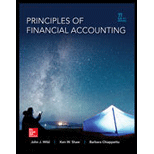
1.
Prepare entries to record both the dividend declaration and its distribution.
1.
Explanation of Solution
Stock dividends: Stock dividends are the number of shares issued by a company to the existing shareholders in a proportion equal to the number of shares owned by each shareholder, based on a stock dividend percentage.
Prepare the
| Date | Account Titles | Debit ($) | Credit ($) |
| February 5 | 480,000 | ||
| Common stock dividend distributable (2) | 120,000 | ||
|
Paid in capital in Excess of par value, Common stock (3) | 360,000 | ||
| (To record the declaration of 20% common stock dividend) |
Table (1)
To record the declaration of 20% common stock dividend:
- Stock dividend is a component of
stockholder’s equity account. While issuing stock dividend retained earnings will decrease. Thus, debit retained earnings account to decrease the retained earnings balance. - Common Stock dividend distributable is a liability account and it is increased. Therefore, credit Common Stock dividend distributable account.
- Paid in capital in Excess of par value, Common stock is a component of stockholder’s equity account and it is increased. Therefore, credit paid in capital in Excess of par value, Common stock account.
Working Notes:
Compute the number of shares to be issued as dividend.
Compute the decrease in retained earnings.
Compute common stock dividend distributable.
Compute paid-in capital in excess of par value.
Prepare the journal entry to record the dividend declaration as follows:
| Date | Account Titles and Explanation | Post Ref. | Debit ($) | Credit ($) |
| February 28 | Common stock Dividend Distributable (2) | 120,000 | ||
| Common stock, $10 par value | 120,000 | |||
| (To record common stock dividend distributed) |
Table (2)
To record common stock dividend distributed:
- Common Stock dividend distributable is a liability account and it is decreased. Therefore, debit Common Stock dividend distributable account.
- Common Stock is a stockholders’ equity account and it is increased. Therefore, credit Common Stock account.
2.
Compute the book value per share and total book value of the shares immediately before and after the stock dividend of February 5.
2.
Explanation of Solution
Compute the book value per share and total book value of the shares immediately before and after the stock dividend:
| Before | After | |
| Total stockholders’ equity | $1,575,000 | $1,575,000 |
| Divided by: Issued and distributable shares | 60,000 shares | 72,000 shares |
| Book value per share | $26.250 | $21.875 |
| Multiply by: Shares owned | 800 shares | 960 shares |
| Total book value of shares | $21,000 | $21,000 |
Table (3)
Working Note:
Compute the number of shares owned after stock dividend of February 5.
Note: Stock issued (100%) + Stock dividend (20%) = 120%
3.
Compute the total market value of the investor’s shares in part 2 of February 5 and February 28.
3.
Explanation of Solution
Compute the total market value of the investor’s shares in part 2 of February 5 and February 28:
| February 5 | February 28 | |
| Market value per share | $40 | $33.40 |
| Multiply by: Shares owned | 800 shares | 960 shares |
| Total market value of shares owned | $32,000 | $32,064 |
Table (4)
Hence, total market value of the investor’s shares in part 2 of February 5 and February 28 are $32,000 and $32,064, respectively.
Want to see more full solutions like this?
Chapter 13 Solutions
Principles of Financial Accounting.
- Adams Products applies manufacturing overhead to jobs based on direct labor hours used. Overhead costs are expected to total $478,600 for the year, and direct labor usage is estimated at 95,200 hours. For the year, $512,350 of overhead costs are incurred, and 98,900 hours are used. Requirement: Compute the budgeted and actual manufacturing overhead rates for the year. (Round answers to 2 decimal places.)arrow_forwardi need Financial Accounting question answerarrow_forwardKyline Industries has forecast production for the next three months as follows:arrow_forward

 AccountingAccountingISBN:9781337272094Author:WARREN, Carl S., Reeve, James M., Duchac, Jonathan E.Publisher:Cengage Learning,
AccountingAccountingISBN:9781337272094Author:WARREN, Carl S., Reeve, James M., Duchac, Jonathan E.Publisher:Cengage Learning, Accounting Information SystemsAccountingISBN:9781337619202Author:Hall, James A.Publisher:Cengage Learning,
Accounting Information SystemsAccountingISBN:9781337619202Author:Hall, James A.Publisher:Cengage Learning, Horngren's Cost Accounting: A Managerial Emphasis...AccountingISBN:9780134475585Author:Srikant M. Datar, Madhav V. RajanPublisher:PEARSON
Horngren's Cost Accounting: A Managerial Emphasis...AccountingISBN:9780134475585Author:Srikant M. Datar, Madhav V. RajanPublisher:PEARSON Intermediate AccountingAccountingISBN:9781259722660Author:J. David Spiceland, Mark W. Nelson, Wayne M ThomasPublisher:McGraw-Hill Education
Intermediate AccountingAccountingISBN:9781259722660Author:J. David Spiceland, Mark W. Nelson, Wayne M ThomasPublisher:McGraw-Hill Education Financial and Managerial AccountingAccountingISBN:9781259726705Author:John J Wild, Ken W. Shaw, Barbara Chiappetta Fundamental Accounting PrinciplesPublisher:McGraw-Hill Education
Financial and Managerial AccountingAccountingISBN:9781259726705Author:John J Wild, Ken W. Shaw, Barbara Chiappetta Fundamental Accounting PrinciplesPublisher:McGraw-Hill Education





